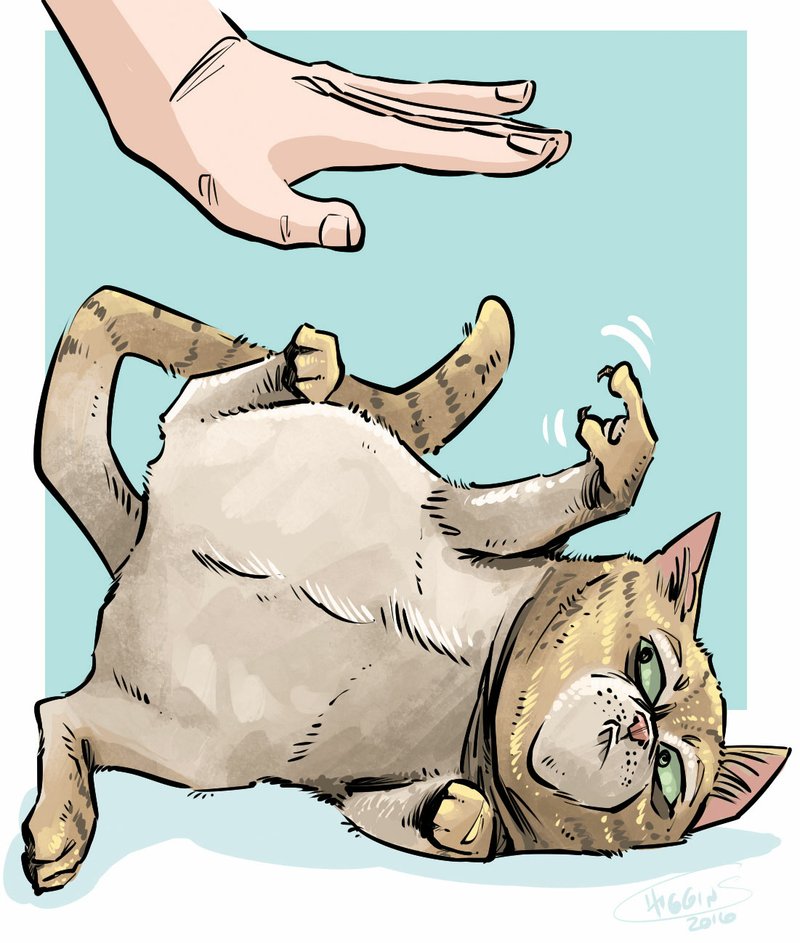I adopted a male cat, Walter, last month. Walter is a wonderful cat, but he gets weird when I rub his belly. He rolls over and shows his belly like he wants to be petted. He seems to like it for about a minute, then all of a sudden he attacks my arm. What's going on?
Experiences like yours aren't uncommon. A cat's body language can be confusing, especially when it appears a cat invites attention, then objects when he gets it.
Some cats enjoy having their tummies stroked or scratched. When they roll over and offer it to their owners, that can mean the cat is relaxed and wants a little attention. But flashing the stomach isn't always an invitation to have it touched,
Years ago I had a large male tabby, Oscar, who liked having his belly petted briefly. When he hit his limit, he would lash out with tooth and claw. After a few startling episodes, I learned to recognize when he'd had enough so I would stop petting and walk away.
The name for Walter and Oscar's apparent ambivalence about belly rubs is "petting aggression," according to Managing Cat Aggression, a publication of the Cummings School of Veterinary Medicine at Tufts University.
"A cat on his back may seem trusting, but he also has all his weapons facing you, at the ready," the book says. "Before you pet any cat's tummy, be sure you know that cat very well."
When my cat was ready for me to stop petting him, he'd grab my hand with his front paws. He'd simultaneously pull up his hind legs in preparation to kick and claw at my arm. That's when I walked away. It wasn't that Oscar didn't enjoy being petted, but that he could stand only so much.
"Cat tummies are extremely sensitive, and the line between pleasure and over-stimulation is quite narrow," according to Managing Cat Aggression.
The book explains that most instances of cat aggression are defensive and occur when the cat is startled, handled roughly or suddenly feels he's in danger. But sometimes cats attack their owners for other reasons. Cats sometimes lash out during playtime, for example. When that happens, it's usually a kitten or young cat that hasn't yet learned "bite inhibition."
When kittens play, they're actually practicing hunting. They learn to stalk, pounce and bite. Kittens also learn from their littermates and mothers how to control their instinct to bite when they're playing. When they don't learn bite inhibition, it's often because they were taken away from their littermates too soon. In some cases, however, a cat's owner or another person could be to blame for the pet's play aggression.
My cat had been a gentle kitten, even when rambunctious, so I was puzzled when he developed a tendency to play rough. I hadn't taught him to do that, but eventually learned the reason behind the behavior when a friend who had kept Oscar for two weeks when I was traveling told me about playing "sock monster" with him. For the game, the friend said, he would cover his hand and forearm with a tube sock, then wrestle with Oscar and let him bite the sock. Oscar loved the sock monster game and, for the rest of his life, couldn't play anything for long without wanting to bite -- hard.
In Managing Cat Aggression, pet owners are advised to never encourage aggressive play or allow a cat to believe a person's hands, arms and faces are toys. An owner should instead direct a cat's play aggression toward appropriate items such as stuffed toys, catnip mice or teaser toys. If a cat begins scratching or biting when playing, a person should end the play session by quietly leaving the area.
Knowing the signs of impending aggression are helpful. These include flattened ears, enlarged pupils, puffed-out fur, spitting, hissing and tail-lashing. If a cat does any of these, play time is over.
Family on 10/05/2016

